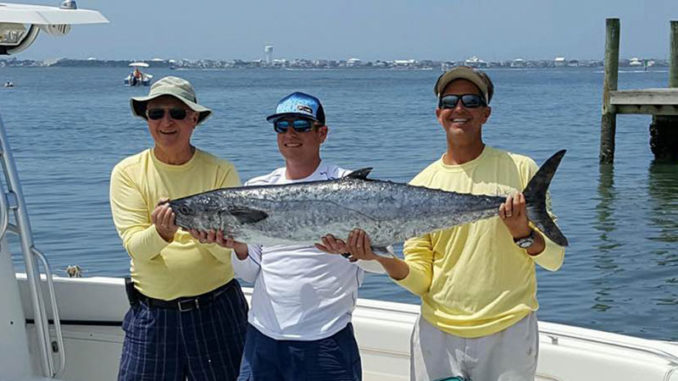
How to make your bait stand out in a crowd
If you’ve ever watched a fishing show, attended a fishing seminar, or watched a pro angler talk about winning a tournament, you’ve heard the term “match the hatch.”
It simply means using lures or bait that resembles the baitfish by which your target species is currently surrounded. It makes sense, but it also begs the question, “How will my lure appeal to the fish if it looks just like all the natural bait around it?”
That’s a good point, too. You want your lure to stand out. Otherwise, what will lead a fish to strike it over all the other baitfish around? Scott Parsons of King Mackerel Tackle in Raleigh, N.C., said it’s possible to do both — match the hatch, and make your lure or bait stand out. He said it’s all in how you present it.
Parsons does a lot of king mackerel fishing and makes custom tackle for himself and as part of his business. He usually fishes from a boat, but he got his start with kings while fishing from piers. Before long, he was “that guy” who was catching more kings than other anglers.
What can you do differently, while still matching the hatch?
“You get out on the end of the pier when the king mackerel are running, and you’re standing elbow to elbow with other guys using the same rigs and the same bait you’re using,” he said. “It’s a lot of just hoping yours is the one the next king mackerel will happen to hit.”
But Parsons quickly realized that if he could make his bait stand out, he’d increase his chances. And he did that by doing just one thing different than the other anglers around him.
“If they were all fishing with heavy weights to keep their baits down, I’d fish my bait on the surface, or at least near it,”
he said. “If everyone else was fishing near the top, I’d fish on the bottom. If they were all fishing 40 feet off the pier, I’d cast 50 feet or 30 feet. I was doing pretty much everything everyone else was doing, but changing just one detail.”
But everyone isn’t fishing for king mackerel from a pier, and everyone doesn’t have dozens of other anglers with whom to compare their setups. They can still, however, study the local baitfish and try to match it while still making their bait or lure more noticeable to predators.
Different is good
If you’re fishing for the inshore slam in a creek with live mud minnows, how deep are the baitfish holding? How close or far away from the shore are they staying? Are they moving at a certain speed? Making a subtle change in how you present your bait over what the local baitfish are doing will often trigger bites from fish that seem to pay little attention to a school of mud minnows swimming past.
Some anglers trim the tails on their baitfish before putting them in the water. This is especially helpful because it’s matching the hatch and standing out as injured prey. It’s the same baitfish that’s all around, but it’s acting differently.
Using live bait or an artificial shrimp under a popping cork is another way to make your offering stand out, and it stands out in more than one way. First, that popping noise on the surface isn’t happening with all the other baitfish around. And second, it’s suspended and moving at a different pace than everything else that’s swimming nearby.
Observing other anglers is always helpful
Fishing with other anglers is helpful too, even if it’s not dozens of anglers on the end of a pier. Even fishing with two or three others gives you a basis for comparison. If none of you are catching fish, then figure out what you can do different from the others. Or if you’re all catching fish, but sparingly, try to determine what is triggering the strike, then do that one thing more often.
If your buddies are all using Carolina rigs, try your bait on a jighead instead. If they’re all fishing on the bottom, try yours under a cork. And if all your buddies have their rods in rod holders, hold onto yours instead. The subtle action created in your hands just might trigger a strike when the fishing gets tough.
This is part of the beauty of fishing. It’s more than just tossing out some bait and waiting for a strike. Matching the hatch while also standing out takes trial and error, and the answer might be different on every trip. Figure out that subtle difference that turns the bite on, and you’ll catch more fish.

